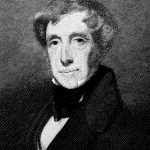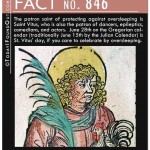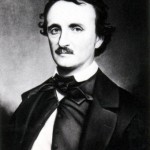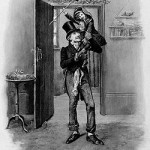Weekly Wrap Volume 68
 The Anonymous Publishing of “The Night Before Christmas,” and Other Interesting Christmas Staple Origins
The Anonymous Publishing of “The Night Before Christmas,” and Other Interesting Christmas Staple Origins
On December 23, 1823, the poem A Visit from St. Nicholas, better known today as The Night Before Christmas was first published. The poem first appeared in the New York Sentinel with no author listed, having been delivered for publication by a friend of Clement Clarke Moore, who was a professor of Greek and Oriental literature and who is generally considered today to have been the author. Before this poem was published, traditions surrounding St. Nicholas were numerous with no real set, near universally accepted idea of “Santa Claus” like we have today. Elements of the… (more)
 What Makes Peanut Butter Sticky?
What Makes Peanut Butter Sticky?
Arachibutyrophobia is a proposed humorous name for the fear of peanut butter getting stuck to the top of your mouth, coined by Charles M. Schulz in a 1982 edition of his famed Peanuts comic strip. But why does peanut butter have such a tendency to get stuck in your palate when so many other foods don’t? As it so happens, peanut butter contains a perfect storm of ingredients seemingly designed with the express intent of creating a peanut flavoured choking hazard. For starters, peanut butter, shockingly enough, contains a lot of peanut oil, which makes it incredibly difficult for your saliva to perform its normal task of helping in this first stage of processing food; as we all know, oil and water don’t really like…(more)
 The Connection Between Saddam’s and Hitler’s Bunkers, Why Your Friends are Likely to Have More Friends Than You, and More, in Yet Another 10 Quick Facts
The Connection Between Saddam’s and Hitler’s Bunkers, Why Your Friends are Likely to Have More Friends Than You, and More, in Yet Another 10 Quick Facts
Quick Fact 841: If you’ve ever felt like your friends are more popular, happier, and wealthier than you… well, on average, you’re probably right. This all comes down to something known as the Generalized Friendship Paradox. The Friendship Paradox was first proposed in 1991 by sociologist Scott L. Feld, who demonstrated that your friends, on average, will have more friends than you. How? Because most people have a very small number of friends, but a small percentage of the population has a relatively large number of friends and you are likely to be friends with at least one or more of these super-popular people precisely because they are very popular. Thus, the average number of friends each of your friends has will be more than the number of friends you have. Similarly, your followers on Twitter, Facebook, and other social networks will, when averaged, have more followers than you. This has since been shown to also apply to things like the number of sexual partners your partners over your life have had; it will, on average, be more than the number you’ve had. Further, Young-Ho Eom of the University of Toulouse and Hang-Hyun Jo of Aalto University demonstrated mathematically that this also applies to your friends, on average, being wealthier and… (more)
In the well-loved A Christmas Carol (it has never been out-of-print since it was first published in 1843), the protagonist (so to speak) is Ebenezer Scrooge, the miserly boss of Bob Cratchit, who lives with his family in poverty while Scrooge enjoys an easy life. One member of the Cratchit family, Tiny Tim, struggles with a crutch and has iron bars on his legs, but the name of his illness is not given. As the story progresses, Scrooge is visited by four ghosts who show him the error of his miserly ways. During the last of these visitations, the Ghost of Christmas Yet to Come shows Scrooge (among other things) that Tiny Tim has died of his ailments.
Ultimately… (more)
 Is it Safe to Eat Moldy Bread or Moldy Cheese?
Is it Safe to Eat Moldy Bread or Moldy Cheese?
For the quick answer to your question: no and sometimes. While not all molds are bad for you to eat, many are, and unless you want to whip out a microscope and meticulously identify the mold present on your food (note: there are 300,000 known types and counting), as a general rule it’s better to avoid moldy foods. Not all molds that are bad for you will cause apparent symptoms right away either. For instance, many molds produce Aflatoxin which is a substance that will up your chances of getting cancer and may cause a variety of other health problems for you, though not necessarily right away. That being said, sometimes it is OK to cut off the mold and eat what’s underneath. As to when it’s OK to eat moldy foods and when it’s not… (more)
Bonus Quick Facts:
- Earthworms are hermaphrodites. When two worms mate, both worms produce children. The worms mate by getting in more or less a 69 position and exchanging sperm with one another. Much later, a cocoon is then secreted by the clitellum band, which is visible near the front of the worm. This is roughly ring shaped. As it’s sliding out of the secreted ring, the worm deposits its eggs and the other worm’s sperm into the ring. The ring then seals itself once the worm is completely out. Eventually, the baby earthworms emerge, lacking only the ability to breed at this point, but otherwise fully developed and ready to go process some soil and be the staple of a lot of animal’s diets. How long it takes for them to emerge from the cocoon depends completely on the environment. The cocoon can keep for years without hatching, if the environment isn’t right, or can hatch quite quickly. One cocoon will typically produce 1-5 worms.
- Certain types of horned lizards are also able to squirt a directed stream of their own blood from the corners of their eyes at predators as much as 5 feet away. They accomplish this squirting action via severely restricting blood flow away from their heads, with the resulting increase in blood pressure in their heads bursting certain vessels near their eyes where the blood squirts from. What purpose does diminishing their own blood supply while giving the predator a taste serve? Well, it turns out to certain animals, such as cats and dogs, horned lizard blood tastes awful due to certain compounds present in their blood.
- The Rubik’s Cube was invented in 1974 by a Hungarian professor of architecture, Erno Rubik. He was toying around one day and attached several blocks together with a rubber band. In this original system, after several twists, the rubber band broke. He then became interested in the structural problem of how to move the blocks independently for an arbitrary number of turns without the cube falling apart. He was eventually successful at solving the structural problem and, shortly after its invention in 1975, he applied for and was granted Hungarian patent HU170062, where his “magic cube” was first marketed. The puzzle was licensed by Rubik to be sold by Ideal Toy Corp, in 1980. Because Rubik had not met the requirements to be able to file an international patent in the time span required, it allowed anyone to manufacture and sell one of these “magic cubes” outside of Hungary. To help get around this problem somewhat, Ideal Toy Corp changed the name to the more memorable and trademarkable “Rubik’s Cube,” rather than sticking with the generic “Magic Cube” name. Rubik was eventually granted patents for the Rubik’s Cube in a variety of countries, such as the United States in 1983.
- While Ben Franklin is remembered as one of the founding fathers of America, his son, William Franklin, was a staunch Loyalist who was ultimately imprisoned during the war and later released as a part of a prisoner exchange in 1778. At this point, he move to British controlled New York City and became President of the Board of Associated Loyalists there. He eventually left for Britain, never to return to America. Needless to say, the relationship between father and son after that was permanently damaged and the two had little contact from then on, with Ben Franklin also leaving his son almost nothing in his will.
- Al Capone got the nickname “Scarface,” due to severe cuts he’d received during a fight with one Frank Gallucio as a young man. At the time, Capone was working at the Harvard Inn, owned by mobster Frankie Yale, as a waiter, bartender, and bouncer. While working, he spotted an attractive woman, Lena Gallucio, who he tried to hit on in what was taken as an insulting manner. Her brother, Gallucio, didn’t take kindly to this and in the ensuing fight gave Capone the three scars on his face and neck that would inspire Capone’s nickname (which he hated). Later, the mob bosses made Capone apologize to Galluccio for insulting his sister and the two reconciled.
- Viggo Mortensen broke two toes while filming the scene where he kicks the helmet by the pyre in the Two Towers, thinking Merry and Pippen were dead. Because of his realistic cry of anguish after kicking the helmet and breaking his toes, Peter Jackson chose that take to include in the movie.
- The book “The Woman and the Car, A Chatty Little Handbook for All Women Who Motor or Who Want to Motor” (presumably extremely chatty, given the title), by Dorothy Levitt written in 1906, recommended that women carry a hand-mirror while driving as it is convenient to be able to see behind you in traffic by holding the hand mirror up. This is the first known mention of rear view mirrors being used in automobiles. The mounted rear view mirror wasn’t available standard in cars until eight years later in 1914. The first person to use a mounted rear-view mirror in an automobile, which he installed himself, was race car driver Ray Harroun. On May 30, 1911 while racing in the Indianapolis 500, Ray was unable to get a mechanic to ride with him during the race. This was the custom at the time as it provided the driver with the ability to know what was happening behind him and to be made aware of any cars about to overtake him. Ray ingeniously installed a mirror on his car instead. He didn’t get this idea from the “Chatty Little Handbook,” but stated he thought of it after remembering seeing a mirror used for this same purpose on a horse-drawn vehicle in 1904.
- Sirius-A is the brightest extrasolar star visible to the naked eye from Earth, being almost twice as bright as the second brightest, Canopus. Sirius-A and Sirius-B combine to form a binary system and appear as one star to the naked eye, though the vast majority of luminosity to the naked eye comes from Sirius-A, Sirius-B being a white dwarf which is only around 30 AU (astronomical units) away from Sirius-A. It is also theorized that there is a Sirius-C, but to date, this has not been proven. Sirius A and B (and possibly C) combine to form a bright point known as Sirius or the “Dog Star”. Sirius-A is a white main sequence star (A1V) that is about twice the size of our Sun. The extreme brightness from our point of view comes not so much because it is a particularly bright star, but rather because it is only 8.6 light years away (2.6 parsecs). That’s a really long ways away by standards of distance we normally deal with (about 50 trillion miles or so), but by galactic standards, it’s just next door and is one of our nearest neighbors.
Other Interesting Stuff:
 The Momentous Peanut Butter Hearings
The Momentous Peanut Butter Hearings
An average American child eats about 1,500 peanut butter and jelly sandwiches prior to graduating from high school. That is about a sandwich every four or five days. Americans eat a lot of peanut butter. Besides it being popular and delicious, peanut butter also has had a tremendous impact on how foods are made and labeled today. Thanks to the “Peanut Butter Hearings,” we can now be reasonably sure what we think we are eating is actually what we are eating. Contrary to popular belief… (more)
 The First to Pee on the Moon and Other Interesting Moon Firsts
The First to Pee on the Moon and Other Interesting Moon Firsts
When Neil Armstrong and Buzz Aldrin stepped onto the Moon all those years ago during the Apollo 11 mission, literally everything they did became a record because everything they did that day was the first time in human history someone had done that thing on the Moon, which it turns out wasn’t made of cheese after all. While Armstrong’s first words on the Moon are some of the most famous (and controversial in terms of what he actually said exactly) ever uttered, a lot of the more mundane things astronauts did first on the Moon aren’t as well known. For example, after Aldrin joined Armstrong on the surface of the Moon, one of the first things the pair did was hop around like… (more)
You may have wondered, if you’ve ever thought about it, why there is an “r” in “Mrs.” when it’s generally spoken as “missus” (also sometimes spelled “missis”). “Mrs.” first popped up as an abbreviation for “mistress” in the late 16th century. At the time, “mistress” didn’t popularly have the negative connotation it often does today, namely referring to a woman other than a man’s wife who he has an affair with. Instead, back then “mistress”, deriving from the Old French “maistresse” (female master), was just the feminine form of “mister/master”. “Mistress” itself first popped up in English around the 14th century, originally meaning “female teacher, governess”. By the 16th century “mistress” referred to any woman, with neither “mistress” nor “mister” referencing… (more)
 How the Milky Way Got Its Name and What It’s Called in Other Languages
How the Milky Way Got Its Name and What It’s Called in Other Languages
No, it has nothing to do with the candy bar. Like many words we use today, the English name of our galaxy is derived from its Latin name: Via Lactea. Translated, that means “the road of milk.” The Romans actually got the name from the Greeks, who called our galaxy “galaxias kyklos” or “milky circle.” Incidentally, the Greek name is also where we get the term “galaxy.” No one knows exactly who came up with the name, but it isn’t difficult to see how the name came about. From Earth, at least if you’re well outside the boundaries of city lights, our galaxy looks something like a band of milky light over a black background, as we are viewing it… (more)
 Edgar Allan Poe was Once Court-Martialed And Convicted
Edgar Allan Poe was Once Court-Martialed And Convicted
Edgar Allan Poe is probably best known for his raven that squawks “Nevermore,” but he’s also one of the first American short story writers and is often credited with being the “inventor” of detective fiction. He also contributed heavily to the genre of science fiction. Not only that, but he was one of the first American writers to earn a living from his writing alone. What’s not as well-known about the man is that Poe had a somewhat turbulent stint in the military. The trouble began when Poe enrolled in a course at the University of Virginia. His foster father gave him a $100 (about $2,000 today) to cover living expenses for the year. Any university student today can tell you that university fees add up—the courses… (more)
This Week’s Podcast Episodes:
- Podcast Episode #296: Mark Twain and His Curious Aquarium
- Podcast Episode #297: Rockin’ Around the Christmas Tree
- Podcast Episode #298: The Invention of Eggnog
- Podcast Episode #299: Tinkle Bells
- Podcast Episode #300: Tiny Tim’s Illness
Quote of the Week:
- “My wife, like many women, actually LIKES wrapping things. If she gives you a gift that requires batteries, she wraps the batteries separately, which to me is very close to being a symptom of mental illness.” – Dave Barry
| Share the Knowledge! |
|






